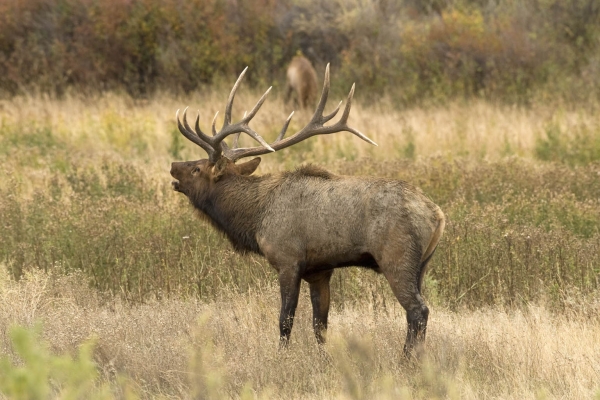
The information on this page is intended as a guide to assist hunters and does not contain all Refuge regulations. Please visit our Rules and Policies page for our complete Visitor Use Regulations.
Permits and Licenses
To get started with general information on Montana hunting districts, permits, licenses and seasons, visit the Montana Fish, Wildlife & Parks hunting website.
The Refuge is open to big game (antelope, bighorn sheep, elk, mule deer, white-tailed deer), bird (waterfowl, upland game, turkey and webless migratory bird), mountain lion and coyote hunting. All other wildlife is protected. You are required to comply with all State regulations and obtain a permit or license for each animal as required by the State of Montana. Once a state issued license or permit is obtained, it is legal to hunt within the boundaries of the Refuge within the designated hunting district for your permit or license.
No additional licenses or permits are required for hunting on the Refuge but hunting seasons and harvest quotas on the Refuge may be more restrictive than State regulations. Consult the current-year Charles M. Russell NWR Hunting Regulations in our Library for more information.
Maps
A brochure with a map of the Refuge and visitor use regulations is available at the Lewistown office or at the Sand Creek and Fort Peck Field Stations. Or email us at cmr@fws.gov to request a copy by mail.
A georeferenced PDF of the Refuge map can be found in our Library.
The area around the Fort Peck Dam is open to hunting under the jurisdiction of the U.S. Army Corps of Engineers. Maps detailing the hunting areas and restrictions can be found in our Library or call the U.S. Army Corps of Engineers, Fort Peck Project at (406) 526-3411 for more information.
Species Information and Population Numbers
All big game surveys are conducted by Montana Fish, Wildlife & Parks and you can find species information and population numbers from the most recent surveys at https://fwp.mt.gov/conservation/wildlife-management/ .
Big Game Hunting
Mule deer, antelope and elk hunting are very popular on the refuge. Mule deer are found throughout the entire Refuge and numbers will vary from year to year. Elk occur on most parts of the Refuge with the exception of the area around the Big Dry Arm. Bighorn sheep hunting is permitted on the refuge, but permits are limited. Some white-tailed deer inhabit areas along the Missouri River and its tributaries, but are not nearly as common as mule deer.
Upland Bird and Waterfowl Hunting
Sage grouse, sharp-tailed grouse, pheasants and grey partridge occur on the Refuge. Small game numbers fluctuate considerably from year-to-year, depending on winter survival and spring nesting conditions. Dove hunting opportunities are also available on the refuge, but the window of opportunity is short as doves usually migrate out of this area by early September. Huntable populations of ducks and geese also occur along the Fort Peck Reservoir and the Missouri River. Most hunting opportunity is in the fields where birds go out to feed, but many islands on free-flowing portions of the river provide a good quality hunting opportunity.
Accessible Hunting
Charles M. Russell National Wildlife Refuge has two hunting and wildlife viewing blinds available for use. The purpose of these accessible blinds is to increase universally accessible hunting and viewing opportunities for all outdoor enthusiasts in the Missouri River Breaks.
The Hell Creek Blind is located in the bottoms of Hell Creek, approximately twenty-five miles north of Jordan, MT, close to Hell Creek State Park. The structure was built by Shadow Hunter Blinds and is a “Total View”; 6’x6’ permanent aluminum insulated blind overlooking Hell Creek. The accessible hunting and wildlife viewing blind consists of 4 corner windows that can accommodate a bow and arrow as well as 4 side windows that can accommodate a rifle or crossbow. The blind is accessible by a hard packed gravel mixture accessible parking lot and 100 yard long trail. The blind offers several different hunting opportunities for species such as mule deer, whitetail deer, and even an occasional elk along with a multitude of other wildlife for viewing. The blind was purposely placed in close proximity to two man-made osprey nesting platforms that are being used annually which provides for great photography potential as well.
The Manning Blind is located along the Missouri River (Manning Bottoms) on the western side of the refuge and is approximately 10 miles east of Highway 191 and the Fred Robinson Bridge. The 6x8 wheelchair friendly viewing blind was built by Shadow Hunter Blinds and can be accessed by a 400 yard hard packed gravel trail. The aluminum blind is insulated and has 6 sliding windows for 360-degree views. The Missouri River riparian riparian
Definition of riparian habitat or riparian areas.
Learn more about riparian corridor offers opportunities to view elk, whitetail deer, mule deer and a multitude of other wildlife.
Both of these blinds are open to the general public with the understanding that visitors with disabilities have priority use. They are available on a first come, first serve basis. If you would like more information on the Hell Creek Blind, please call 406-526-3464. For more information on the Manning Blind, please call 406-464-5181.
